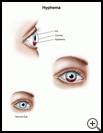
Blood in the Front of the Eye (Hyphema)
_______________________________________________________________________
KEY POINTS
- A hyphema is a pool of blood in the area between the iris, which is the colored part of the eye, and the cornea, which is the clear outer layer on the front of the eye.
- Most of the time, the blood will go away on its own. Your child’s healthcare provider may tell your child to rest with his head raised, wear an eye shield, avoid bending and strenuous activity, and use eye drops. Your child may need surgery to help clear the blood from the front of the eye.
________________________________________________________________________
What is a hyphema?
A hyphema is a pool of blood in the area between the iris, which is the colored part of your eye, and the cornea, which is the clear outer layer on the front of your eye. The blood can block light from reaching the back of your eye, or cause the pressure inside your eye to increase. Both of these can cause blurry vision.
If a hyphema is not treated, it can cause a permanent loss of vision.
What is the cause?
A hyphema is usually caused in one of two ways:
- Injury to your eye
- Medical problems such as diabetes, poor blood flow to your eye, and inflammation or tumors that cause abnormal blood vessels to bleed
What are the symptoms?
Symptoms may include:
- Decreased vision or blurry vision
- Eye pain or a feeling of pressure in your child’s eye
- Painful sensitivity to light
- Blood pooled in the front of your child’s iris
How is it diagnosed?
Your child’s healthcare provider will ask about symptoms and medical history and do exams and tests such as:
- An exam using a microscope with a light attached, called a slit lamp, to look closely at the front and back of your child’s eye
- An exam using drops to enlarge, or dilate, your child’s pupils and a light to look into the back of your child’s eyes
- An eye pressure test, which uses a small puff of air that is blown against your child’s open eye or a device that briefly touches the eye after it has been numbed with drops to measure the pressure inside the eye
- An ultrasound, which uses sound waves to show pictures of the back of your child’s eye
- Blood tests to check for sickle cell trait. Children with sickle cell trait or sickle cell disease have an increased risk of high eye pressure and vision loss from hyphema.
How is it treated?
Call your child’s healthcare provider right away if you notice blood in the front of the eye. Most of the time, the blood will go away on its own. Often, your healthcare provider will tell you to have your child:
- Avoid bending and strenuous activity.
- Rest in bed with his head raised on several pillows to allow the blood to settle.
- Wear an eye shield to protect your child’s eye.
- Use eye drops to decrease the swelling and irritation or lower pressure in the eye.
Your child may need surgery to help clear the blood from the front of the eye. Your child is more likely to need surgery if:
- The blood fills the entire front of the eye.
- Your child has sickle cell trait or sickle cell disease.
- Your child’s eye pressure stays high even with treatment.
- The blood in the front of your child’s eye starts to stain the cornea
- Your child’s eye bleeds again.
The risk for the eye bleeding again is highest in the first week after the bleeding started. If the eye does not bleed again, the hyphema will usually heal in one or two weeks, depending on how much blood is present.
How can I take care of my child?
Follow the full course of treatment your healthcare provider prescribes. Ask your healthcare provider:
- How and when you will get your child’s test results
- How long it will take to recover
- If there are activities your child should avoid and when he can return to his normal activities
- How to take care of your child at home
- What symptoms or problems you should watch for and what to do if your child has them
Make sure you know when your child should come back for a checkup. Your child may be at risk for other eye conditions such as glaucoma because of the hyphema.
How can I prevent hyphema?
- To help prevent severe eye injuries, make sure that your child wears safety eyewear when he:
- Is around power tools, chemicals, or splatter of any kind
- Plays paintball, racquetball, lacrosse, hockey, and fast-pitch softball
- Make sure that your child is always correctly secured in a car seat or always wears a seatbelt to decrease injuries from car accidents.
- Make sure that your child has regular eye exams, especially if he has a health condition such as diabetes.
Last modified: 2016-11-01
Last reviewed: 2017-10-02

